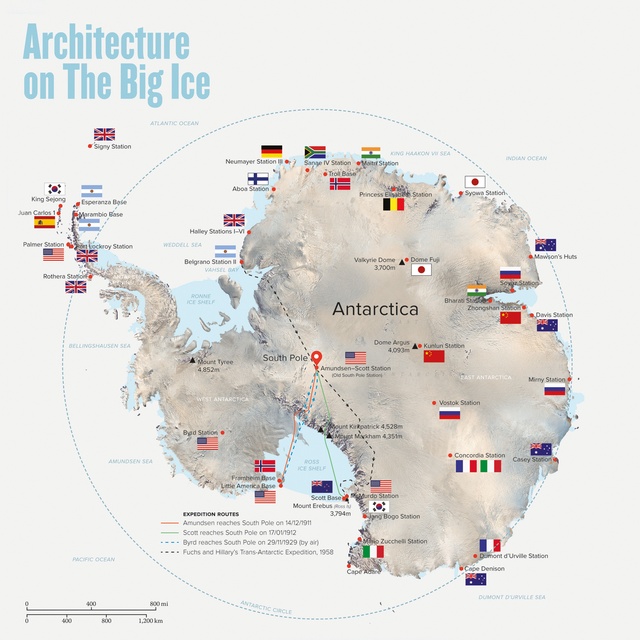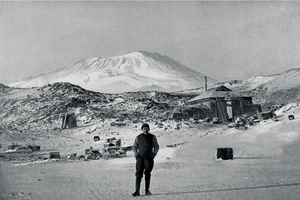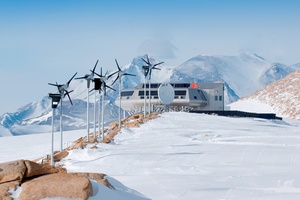Architecture on The Big Ice
Antarctica is one of the most inhospitable places on Earth, likened to the extremes found on other planets. So, what does it take to design for such a unique environment? In the first of our three-part Antarctica series, Architecture New Zealand gives an introduction to the history of exploration on this enticing and enigmatic continent.

See a detailed view of the map here and click here to see our timeline of the history of architecture in Antarctica.
Since it was first discovered in the 18th century, Antarctica has fascinated humans endlessly with its awe-inspiring icy landscapes and extraordinary wildlife. It is regarded as one of the last true wildernesses – still relatively unblemished by human intervention and habitation. Yet, it is hugely important to the rest of the world.

The continent comprises more than 10 per cent of the Earth’s surface and drives the climate and ocean circulation of the planet. This means that changes in Antarctica can be felt around the globe, making it an obvious home for leading international scientific research, such as how ice sheets respond to changes in oceanic and atmospheric conditions.
In the New Zealand-claimed Ross Dependency, the Ross Ice Shelf is a floating extension of the planet’s biggest ice sheet and the largest ice shelf on the continent; yet, surprisingly little is known about it. At New Zealand’s Scott Base, Antarctica New Zealand’s scientists are trying to gain a greater understanding of its dynamics because its probable response to a warming climate is critical to forecasting sea level change, which is expected to increasingly affect coastal towns and cities around the globe in coming decades.
There are now more than 40 year-round and 20 seasonal research stations widely distributed across Antarctica, including New Zealand, Australia, Argentina, the United States, Chile and Germany, while, in recent years, Russia, China, India, Iran, Turkey and Britain have been building or expanding bases there, also. It is clear that most countries are there for purely scientific reasons but, in the future, the continent could present a bounty of untapped resources!
Previously, Antarctica’s mineral wealth was seen as too expensive to extract but a warming climate and new technologies will increasingly make extraction viable by 2048, when the 2016 agreement of 29 countries banning mining in Antarctica comes up for review.
It is no wonder, then, that Antarctica’s population of people performing and supporting research is growing: it currently varies in number from around 4,000 during the summer season to 1,000 during winter.
And, in order to attract the most skilled scientists, countries need to have better-designed facilities. These research stations are also showcases for individual nations’ interests in Antarctica, so it would seem that installing an ‘architectural’ building on the ice could be the modern equivalent to the early-20th-century race to reach the Geographic South Pole.

The race to the Pole began when explorers started to run out of places to reach first; it became known as the ‘Heroic Age of Antarctic Exploration’. After a succession of failed attempts by various countries, the race was won by Roald Amundsen’s Norwegian expedition on December 1911. Following closely behind – arriving at the pole one month later – was Robert Falcon Scott’s British expedition party. Scott’s mission was, sadly, to become more famous though, because of the tragedy of the entire team perishing during its journey back to the coast.
In such an inhospitable environment, adequate base camps with plentiful supplies and equipment were absolutely essential to early explorers’ – and now to modern scientists’ –survival. Many of the historic huts have recently been restored to capture the incredible stories associated with their associated expeditions. Since 2006, the Antarctic Heritage Trust (NZ) has engaged more than 60 international heritage and conservation specialists to work in what is the most challenging heritage conservation environment on Earth. Last year, it completed a major phase of conservation work, part of which was the conservation of four historic bases, including Scott’s and Shackleton’s, and more than 18,000 artefacts.
Watch this space for an examination of restoration of the early expedition huts by the Antarctic Heritage Trust (NZ) and an interview with a leading designer of polar research facilities, Hugh Broughton, and Stephen Middleton of Jasmax, who are collaborating with Broughton on a design at Scott Base.
The interactive map at the top of this page was created by André Kini, Justine Harvey and Hugh Broughton.
A version of this article first appeared in Architecture New Zealand magazine.










